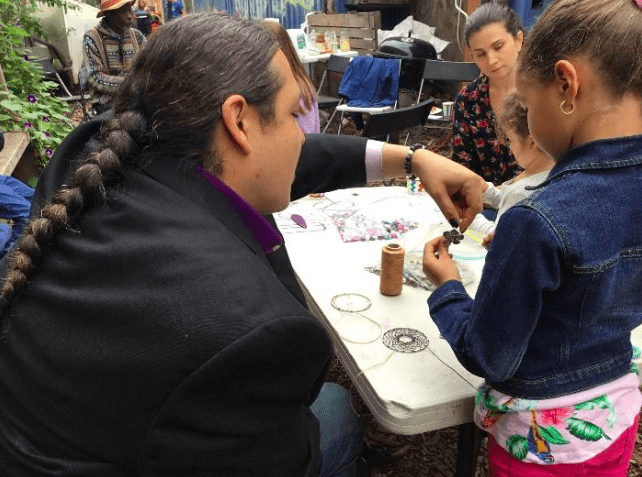
For the last three years, during school holidays and weekends, families and students from Greenpoint Eco-Schools have come together on holidays and weekends to experience, explore, and educate themselves about the environment, sustainability, and Greenpoint. On October 8, twenty-five people gathered at North Brooklyn Boat Club (NBBC) to canoe down Newtown Creek and celebrate Indigenous Peoples Day (formerly known as Columbus Day).
Phillip Stands, from American Indian Community House, joined us to explain the significance of Indigenous Peoples Day (IPD) and to share First Nation Peoples’ songs, stories and crafts. “Indigenous Peoples Day recognizes that First Nation People are the original inhabitants of the Americas, including the lands that later became the United States of America. And it urges Americans to rethink history.” NYC has celebrated the day since 2014 with a two-day event at Randall’s Island. This year, Bushwick Inlet Park, American Indian Community House, and Friends of Transmitter Park co-hosted an event to celebrate and recognize Indigenous Peoples Day and connect the American Indian Community House with North Brooklyn.

The event at NBBC was designed to explore indigenous values, culture and ethics through environmental teachings and knowledge of how to coexist with nature. Phillip graced us with storytelling and song that encourages us all to protect our waterways and live in harmony with nature. Our Eco-families can deepen their connections with one another by learning about Newtown Creek, the waterways of Greenpoint, and most importantly, First Nation People.
While waiting to canoe, families participated in a number of hands-on educational components and activities including NBBC’s center piece aquarium, water quality monitoring, plankton sampling and observation tank and compost system. They also learned about the Lenape People, who are indigenous to Brooklyn and made Dream Catchers. The day was filled with smiles and laughter as families selected beads for their Dream Catchers.

“First Nation People believe that the night air is filled with dreams, both good and bad. When hung above the bed in a place where the morning sunlight can hit it, the dream catcher attracts and catches all sorts of dreams and thoughts into its webs. Good dreams pass through and gently slide down the feathers to comfort the sleeper below. Bad dreams, however, are caught up in its protective net and destroyed, burned up in the light of day,” explains Phillip.
Everyone worked together to make Dream Catchers that will catch our collective dream of a sustainable and just world.




